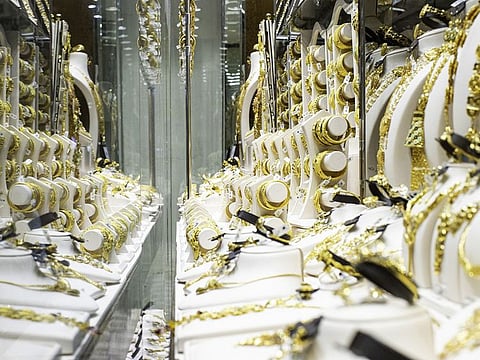UAE gold price prediction: Time to buy? Prices may be slipping now, but not for long
Gold prices fell for the second time in three days, but hovers at buyer-averse levels

Gold prices fell for the second time in three days amid weak global cues, but hovers at buyer-averse levels. Global gold prices eased as a rally in equity markets dimmed the safe-haven metal's appeal.
Gold prices lost its shine after plunging recently to about $1,760 (Dh6,465), which led to a rush in demand among buyers. Gold prices fell 0.2 per cent to $1,801 (Dh6,615) per ounce.
Gold prices are usually dependant of global cues, wider market-moving events and anything that concerns the top economies.
In the UAE, data showed 24-karat price dropping from Dh219 per gram to Dh218.5 at the market's opening on Monday.
Among other variations of the precious metal, 22 karat was trading at Dh205.25, 21 karat at Dh195.75 and 18 karat at Dh167.75 per gram.
Commodity analysts say there is potential for a further positive push in gold prices. However, for now a slightly stronger US dollar will put negative price pressure on the precious metal’s prices.
Gold prices are seen range-bound between $1,790 (Dh6,575) and $1,830 (Dh6,721), meaning there is no strong move in either direction. When range-bound, prices tend to ping back and forth near old highs.
So, as the world’s top economy, the US, is expected to put out inflation data in the coming days and as traders await the data, the prospect of the prices hangs in the balance.
Gold prices were pushed down 6 per cent in June after a surprise hawkish shift in stance by the central bank. The US central bank equivalent or Federal Reserve chairman's testimony is also due this week.
Buyers, investors and analysts will closely watch the commentary for hints of monetary policy tightening by the US central bank, as this will be a potential shift in stance tracked by central banks worldwide.
An upsurge in new COVID-19 variants and poor access to vaccines in developing countries threaten the global economic recovery, finance ministers of the world's 20 largest economies warned on Saturday.
The latest variant of the virus has created uncertainties for the larger stock market with the rise in number of cases, and as risk-driven stocks drop, the prices of safe-haven assets like gold rise.
Demand for physical gold in key hubs have weakened as buyers were put off by a rise in price, while premiums for the bullion (high purity physical gold kept in the form of bars, ingots, coins) also recoiled.
Gold being a non-interest-bearing metal, also benefited last week from a sharp drop in US government bond yields – notably the longer-dated US 10-year yields which fell to its lowest since February.
Meanwhile, reserve requirement ratio (RRR) cut (the amount of cash banks must hold) by China’s central bank also suggests the world’s second-largest economy is concerned about growth.
Gold’s credentials as a hedge against unforeseen developments seem to have strengthened during the past few weeks and could be headed for more gains in the weeks ahead.
“The shifting focus of markets saw commodities endure a rollercoaster ride last week,” analysts at Australia-based ANZ Bank wrote in a research note. "However, they maintained a positive trajectory."
Meanwhile, the US dollar has been ruffled of late. The European Central Bank has played a role in the US dollar's downside.
Last week, the European Central Bank (ECB) set a new inflation target on Thursday that pushed the euro higher, making for a less US dollar optimistic environment for the immediate future.
The central bank meeting and inflation data will continue to underpin the US dollar for the week ahead and deter declining trends from stepping in too early in case the data raises the inflation risk tone again.
Interest rates also drive gold prices in the short and medium term. The negative impact higher rates could bring will be offset by the longer-lasting effects of expansionary monetary and fiscal policies.
These may include inflation and higher exposure to risk-on assets in portfolios. These factors could prompt investors to add gold to their allocation strategies during the second half of the year.
However, while consumers may also benefit from the economic recovery and recent price pullback, new COVID-19 variants may limit uptake in gold jewellery in key markets.
The first half of 2021 provided a good example of how gold’s diverse sources of demand and supply interact. The gold price dropped by 6.6 per cent in the first half.
This is as gains during most of the second quarter were thwarted by a significant pullback in late June.
Overall, gold’s performance was driven primarily by higher interest rates – especially during the first quarter and then again in late June on the back of a more hawkish-than-expected statement by the US central bank.
Gold was also influenced by upbeat investor sentiment as the global economy started to recover from the impact of COVID-19.
However, there were supporting factors for gold. Concerns of higher inflation offset part of the drag that interest rates brought.
And the response from governments to aid economic recovery in the form of monetary and fiscal policies has made some investors worried about currency risks and capital preservation.
In addition, gold benefited from a recovery in consumer demand in the first quarter, although second waves of the virus and new lockdowns presented challenges in the second quarter, analysts note.
Sign up for the Daily Briefing
Get the latest news and updates straight to your inbox









